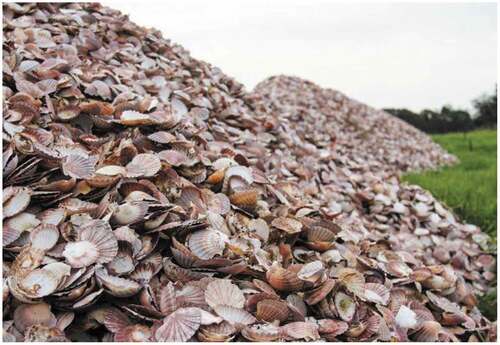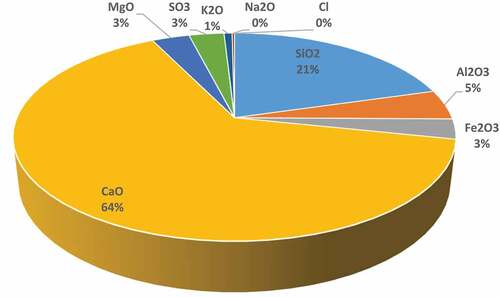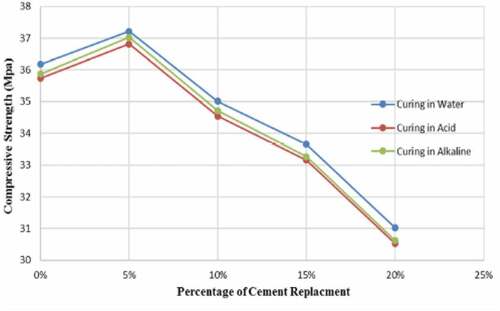 ?Mathematical formulae have been encoded as MathML and are displayed in this HTML version using MathJax in order to improve their display. Uncheck the box to turn MathJax off. This feature requires Javascript. Click on a formula to zoom.
?Mathematical formulae have been encoded as MathML and are displayed in this HTML version using MathJax in order to improve their display. Uncheck the box to turn MathJax off. This feature requires Javascript. Click on a formula to zoom.Abstract
This study reviews recent literature on the mechanical and durability properties of concrete incorporating seashells as partial or full substitutes for conventional materials. The study summarizes various contributions elucidating the various waste seashells utilized, the growing worldwide aquaculture production, seashell material preparation and treatment, chemical composition, physical properties, and different mechanical and durability test methods adopted by previous studies such as compressive strength, split tensile strength, flexural strength, modulus of elasticity, freeze-thaw resistance, water permeability, air content, chemical attack, carbonation, and weight loss. The study showed that mechanical properties indicate reductions of different percentages with increases in substitution ratio at 5% to 75%, compared to control mixes. However, relative increases in mechanical strength were recorded with the increase in curing age up to 90 days. Influence of seashells on durability properties varied across various durability tests at different seashell percentages. In a nutshell, the use of seashells in concrete production has a good effect, and further innovative research can solidify its utilization in the drive towards sustainable development.
PUBLIC INTEREST STATEMENT
Seashells have been used as partial replacement for fine or coarse aggregate of concrete in various percentages, as admixtures in a concrete mix, partial cement replacement, and the development of pervious concrete. The use of seashells in concrete production reduces environmental pollution and the demand for natural aggregates. This research focuses on the review of the mechanical and durability assessment of concrete containing seashells. The use of seashells as either fine, coarse, and binder in concrete production needs to be carefully examined to ascertain how durable it is in the construction industry. This calls for the review of what researchers have done using different seashells in concrete production, the threshold they established for each seashell, and the identification of areas for further studies.
1. Introduction
Concrete is an everyday material; its adaptability and availability have made it of great importance for all construction in the world (Bamigboye et al., Citation2019). Concrete in volume terms is among the most widely used synthetic materials (Martínez-García et al., Citation2017; Sojobi et al., Citation2016). Much research has been done on fully or partially replacing the concrete constituents with waste materials from our surroundings. The continuous demand for environmental protection and the maximum utilization of raw materials for the achievement of sustainable development challenged civil engineers to focus on designing structures to meet serviceability requirements and consider the effect of their projects on the environment (Soltanzadeh et al., Citation2018). Research that involved the re-use of solid wastes in cement-based materials has been practiced for years (Muthaiyan & Thirumalai, Citation2017; Ponnada et al., Citation2016; J. Wang et al., Citation2019). It reduces the amount of waste discharged to the environment through landfill. It also facilitates sustainable development by recycling wastes as cementitious construction alternatives (Bamigboye et al., Citation2021a; Schneider et al., Citation2011). Although concrete usage is continually increasing as a construction material, it also has resulted in a relative increase in demand for concrete materials. The vehement applications of natural aggregates in concrete production is resulting in the depletion of these natural resources (Matias et al., Citation2014; Pepe et al., Citation2014; Silva et al., Citation2014; Gonzalez-Corominas et al., Citation2016; Bamigboye et al., Citation2019; G.O. Bamigboye et al., Citation2021b). The use of waste seashell as a partial replacement for construction material in various ratios can aid in lessening the danger of exhaustion of naturally occurring materials while also controlling the environmental challenges associated with climate change and the ever-rising costs of producing construction materials (Ammari et al., Citation2017; Fatemeh et al., Citation2018; Soltanzadeh et al., Citation2018).
Due to their endless diversity, seashells can be collected around the world. Their majestic form, bright colors, and abundance along seashores are also reasons they are sorted after (Neamitha & Muthadhi, Citation2016; Ong & Kassim, Citation2019). Seashells have been used for many years as ornaments, coins, and tools (Kim et al., Citation2018; J. Wang et al., Citation2019). They are tough exoskeleton of sea mollusks such as bivalves, chitons, and snails that protect and support their bodies. It is made up mainly of secreted calcium carbonate with a skin-like tissue in the mollusks’ body wall (Anieti-mfon & Etuk, Citation2016; G. L. Yoon et al., Citation2003). Seashells are composed of several distinct layers of microstructures with different mechanical properties (Gadgihalli et al., Citation2017; Tayeh et al., Citation2019), including strength and toughness. The properties have been explored by many types of research, thus looking for its benefits in other areas. Hung et al. (Citation2018) identified seashells as another readily available waste material, most of which are used for landfilling with a small percentage re-used for other purposes, such as handicrafts and fertilizers. Yearly, huge amounts of seashells are generated as waste in the seafood and aquaculture industries worldwide (“Food and Agriculture Organization of the United Nations,” Citation2016; Mohammad et al., Citation2017). shows a mound of seashell wastes dumped in an open field.
Waste seashells are of diverse kinds, and they include mussel shells, scallop shells, oyster shells, cockle shells, and periwinkle shells (Hazurina et al., Citation2013; Nordin et al., Citation2015; Pusit et al., Citation2012). In nations like China, Taiwan, and South Korea, oyster shells, a very common waste agent, are highly problematic, as such, it was reported that nearly 370–700 g of shell wastes are generated from every 1 kg of oyster consumed (Yao et al., Citation2014). It is noted that the Galicia region is the second-largest producer of mussel shells and is located in the north of Spain (Martínez-García et al., Citation2017). In Peru, around 25,000 tons of scallop shell waste is produced annually, resulting in environmental pollution when disposed of in open areas (Varhen et al., Citation2017). In Nigeria, local foods are prepared with periwinkle, and waste shells are disposed of after eating. These waste shells cause high deposits because an insignificant percentage is recycled by the locals as coarse aggregate in concrete (Falade, Citation1995; Osarenmwinda & Awaro, Citation2009; Otunyo et al., Citation2013). In Europe, the fishing and shellfish farming industries are vital. Annually, about 45,000 tons of shellfish and 160,000 tons of shells from shellfish breeding are produced (Mer, Citation2011). In the year 2011, estimates from Malaysia’s Department of Fisheries indicated that the amount of cockle shell harvested was about 57,544.40 tons along the west coast of Peninsular in Malaysia with Pahang and Johor inclusive (Othman et al., Citation2013). In 2007, Indonesia generated about 64,641 tons of pearl oysters, 420 tons of green mussels, and 205 tons of blood cockles, respectively (Ministry of Marine and Fisheries (MMF), Citation2007). shows the percentage of worldwide aquaculture production of mollusk shellfishes.
Figure 2. Aquaculture percentage production of shellfishes worldwide Source: FAO, (Food and Agriculture Organization of the United Nations) (Citation2014) as cited in (Eziefula et al., Citation2018)
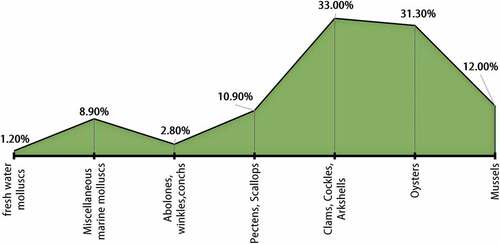
There are numerous possibilities in which seashells have been recycled for their properties in the construction sector. Grounded seashells have been used to replace fine aggregate, thus producing a self-compacting concrete (Brahim et al., Citation2015). Safi et al. (Citation2015), in a study on completely replacing sand with seashell, developed a self-compacting mortar. The authors discovered that the mortar flowed suitably without being vibrated, and there was no detection of bleeding or segregation. The total replacement of sand with seashell also showed a slight decrease in modulus of elasticity and compressive strength at 28-days. Seashells have also been applied as additives in cement manufacturing. It has been discovered in several studies that calcium carbonate (CaCO3) is a major chemical component of seashells with about 90% by weight. Authors like Yang et al. (Citation2010), Zaid and Ghorpad (Citation2014), and Umoh and Ujene (Citation2015), Martínez-Martínez-García et al. (Citation2017), Soltanzadeh et al. (Citation2018), and Bamigboye et al. (Citation2021a), through their publication, have contributed to this research claiming that seashells have the potential to be a substitute for conventional limestone in the production of cement.
Over two decades, several research types on the usage of seashells as a substitute to aggregate in concrete have been conducted to establish a feasible practice that can be applied (Eziefula et al., Citation2018; Lalitha & Raju, Citation2014). This review also shines the light on seashells’ various applications as a substitute for concrete materials, durability, and mechanical properties. summarize previous research done where seashells were introduced in concrete.
Table 1. A research summary on the mechanical strength of seashells by various authors
Table 2. A research summary on the durability of seashells concrete by various authors
2. Methods
This paper is focused on the mechanical and durability properties of concrete containing seashells. The method adopted in this study includes a review of recent relevant works of literature to understand and present the state-of-the-practice on the subject matter to guide present-day concreting works and future researchers. The review also focuses on seashells as a material, their effect on the strength and durability of concrete, the various reports in the tests carried out, and attempts to correlate the results on mechanical and durability properties. Lastly, the review highlights recommendations for future researchers.
3. Preparation and treatment of materials
Various methods of preparation have been used in the past to treat seashells. Varhen et al. (Citation2017) mentioned that empty seashells could be collected from landfills, washed with water, and brushed to remove dirt or organic matter, and afterward, dried. They could be crushed manually using a hammer or a steel drum rotating grinder (abrasion machine), which contains standard steel balls (Agwu et al., Citation2020; Bamigboye et al., Citation2020; Soltanzadeh et al., Citation2018). The seashells used by Mutusva and H.G., N., C. (Citation2015) were first washed in cold water and later with hot water containing vinegar. After that, the shells were sundried, and the shells of particle size greater than 4.75 mm were considered for use as coarse aggregates replacement.
In addition to the washing and sun-drying, seashells are subjected to heat from ovens at various time intervals to disinfect and dehydrate the shells (Eziefula et al., Citation2018). Crushed seashells are sieved with different sieve sizes based on aggregate type (fine or coarse aggregates) (Olivia & Oktaviani, Citation2017). The chemical composition of seashells can be obtained using the XRF test (X-ray fluorescence spectroscopic analysis) (Soltanzadeh et al., Citation2018); chloride and sulfate contents of seashells can be determined by titration and sedimentation methods (Lertwattanaruk et al., Citation2012).
The cement used in previous studies incorporating seashells as partial replacement is Type 1 Portland cement, usually called ordinary Portland cement (OPC), according to ASTM C150. Portland cement is gray with fine particles with a relative density of around 3.14 with a size range of 2 mm and 80 mm. The particles’ size depends on the clinker grinding process, and its variability depends on the cement requirement (Hazurina et al., Citation2013). Previous studies also used cement types such as Portland cement mixed with fly ash containing 6–20% siliceous and limestone (CEM II/A) and blast-furnace slag blended with moderate sulfate-resistant Portland cement (Eziefula et al., Citation2018). The chemical components of Portland cement are shown in
In aggregate preparation, previous studies used fine aggregate with a specific gravity (SG) of 2.69, water absorption (WA) of 2.24%, and fineness modulus of 1.90. The coarse aggregate used for concrete production had an SG of 2.42 and WA of 2.64% (Oliva et al., Citation2015). Aggregates used should also conform to the ASTM C33 (Elliott & Fuller, Citation2013).
3.1. Testing methods
The shells’ internal structure can be studied using an electronic microscope equipped with an SEM/EDX analyzer (Martínez-García et al., Citation2017). Classification analysis of the shell is carried out using x-ray fluorescence (XRF) and x-ray diffraction (XRD) (Martínez-García et al., Citation2017; Mohamed et al., Citation2012). The hydration properties of seashell concrete can be analyzed with Differential Thermal Analysis and Thermogravimetric Analysis using a SHIMADZU DTG-60/60 H instrument (Tayeh et al., Citation2020). The workability of concrete is tested using the Slump cone test (Ismail et al., Citation2019; Raseela & George, Citation2019) or the ball-drop test (Kuo et al., Citation2013).
Compressive tests can also be conducted according to European standards EN 12,390 (Attah et al., Citation2019; Hanh et al., Citation2013), ASTM D4832 (Kuo et al., Citation2013), ASTM C39/C39M (Bamigboye et al., Citation2020; Varhen et al., Citation2017), BS 1881 standard (Tayeh et al., Citation2020), ASTM C617 (Khankhaje et al., Citation2017), UNE EN 12,390–3 (Martínez-García et al., Citation2017), ASTM C109 (Soltanzadeh et al., Citation2018). Tensile strength test can be conducted following BS EN 12,390–6:2009 (Ismail et al., Citation2019), ASTM C496 (Khankhaje et al., Citation2017; Tayeh et al., Citation2020; Varhen et al., Citation2017), European Standard EN 1338 (Hanh et al., Citation2013), UNE EN 12,390–6 (Martínez-García et al., Citation2017), SNI 03–2491-2002 (Olivia et al., Citation2015). Flexural strength test can be conducted according to guiding ASTM C348 (Soltanzadeh et al., Citation2018), SNI 02–4431-1997 (Olivia et al., Citation2015).
Elastic modulus test could be carried out according to UNE EN 12,390–13 (Martínez-García et al., Citation2017), ASTM C469 (Olivia et al., Citation2015; Yang et al., Citation2010), Water Permeability test could also be conducted using the RILEM CPS 11.2 guidelines (Ismail et al., Citation2019), ASTM C1754 volumetric method (Khankhaje et al., Citation2017), a permeameter (Hanh et al. Citation2013), ASTM C 109 with the input method carried out as shown in (Yang et al., Citation2010), The UPV testing—ASTM C597-97 through method acoustic (Safi et al., Citation2015), UNE 83,310 (Martínez-García et al., Citation2017). Sulfate attack tests in previous studies were done according to ASTM C1012 (Kuo et al., Citation2013). Freezing and thawing tests were guided according to ASTM C666 (Yang et al., Citation2010), the slow freezing method (Chinese national standards) (W. Wang et al., Citation2020). Drying shrinkage, according to ASTM C596 (Lertwattanaruk et al., Citation2012).
Figure 4. Permeability test procedure (Yang et al., Citation2010)
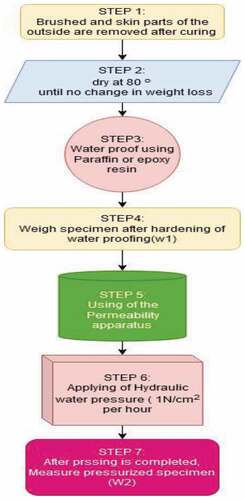
3.2. Chemical component of seashells
The seashells’ chemical components vary depending on shell type and the site where samples are collected (Lertwattanaruk et al., Citation2012). shows an illustration of the chemical elements of oyster shells collected from two different locations (sea and river) alongside the chemical components of six types of seashells. Seashells’ content indicates that it contains calcium carbonate (CaCO3) of about 95–97% with a small number of organic materials and inorganic minerals. Reports mentioned that washing seashells before use enables the reduction of contaminants, organic matters, and ions such as chloride (Martínez-García et al., Citation2017). Calcium oxide (CaO) is an essential component in demand to increase the development of strength and concrete density (Lertwattanaruk et al., Citation2012). With the application of a high temperature of about 500 to 1000 ◦C, CaCO3 converts into carbon and calcium oxide (CaO) (Djobo et al., Citation2016; Li et al., Citation2015; Olivia & Oktaviani, Citation2017; Othman et al., Citation2013). The calcination process through heat can significantly increase pH value and influence the compound formed in the XRD dif-fractogram, most specifically CaO or calcite peaks (Chiou et al., Citation2014; Ez-Zaki et al., Citation2016; Yao et al., Citation2014).
Table 3. Chemical composition of the most commonly used seashells
Abdulfattah (Citation2001) chemical tests conducted in line with the Nigerian standard show that oyster shells, snail shells, and periwinkle shells contain a high percentage of SiO and CaO. About 3% of Sulphur trioxide was also noticed to be present. The presence of silica in a large portion in the oyster, periwinkle, and snail shells, predicts their tendency to be pozzolanic and even the tendency to be a possible material for additional cementitious materials or a decent precursor for the synthesis of alkaline-activated cement or geopolymer if doped with alumina, mostly if such silica is amorphous (Tayeh et al., Citation2019).
3.3. Physical properties of seashell
The seashell size is a dependent factor in the seashell aggregate physical properties, as shown in . Seashell with more coarse-sized particles has a less specific gravity, water absorption, and higher fineness modulus than the finer-sized seashell particles (Bamigboye et al., Citation2021a; Khankhaje et al., Citation2017; Martínez-García et al., Citation2017). shows that the shell thickness of the scallop shell ranges from 2 to 3 mm, and the Periwinkle shell shows a uniformity coefficient of 1.14 − 1.23. Amongst the shells tested, Cockleshell has the least fineness modulus compared to Oyster shell, which indicated the highest test value. The specific gravity for the Mussel shell range was 2.73, while the Oyster shell ranged the least with a value of 1.85. The compacted bulk density test shows that Cockleshell has a higher density than other shells with a weight of 1408–1420 kg/m2. Periwinkle shells showed very high moisture content with values of 1.1–8.32% compared to other shells. The loose bulk density test showed that the periwinkle shell has a loose density of 514 kg/m2, while the scallop shell was higher with a value of 1015 kg/m2. Periwinkle shells indicated a high-water absorption value ranging from 9.03% to 12.99%, and the Cockleshell showed the least with an amount ranging from 0.1% to 2.5%. The seashells’ physical properties from previous studies are shown in , and also shows the particle size distribution of seashells and sand.
Figure 5. Summary of physical properties of seashell from previous studies (Hung et al., Citation2018)
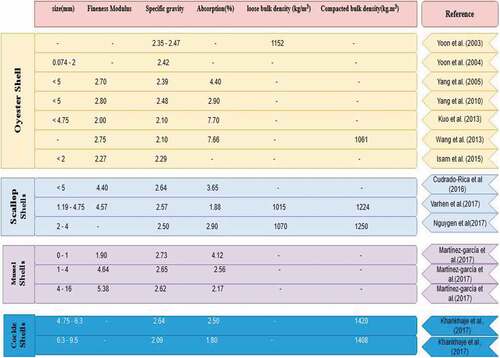
Figure 6. Particle size distribution of crushed seashells and sand (Safi et al., Citation2015)
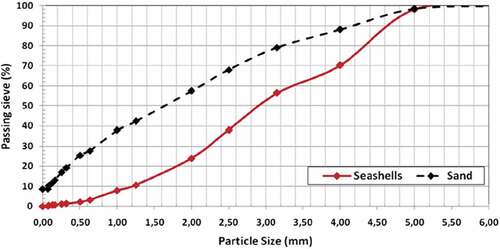
3.4. Seashells mechanical properties
The seashells’ mechanical properties are the physical properties that describe its behavior under loads’ action. lays out results from tests conducted on seashells in previous articles to obtain some mechanical properties. These tests include the Aggregate impact value test, Aggregate abrasion value test, Aggregate crushing, and lastly, the Los Angeles test. The hardness required for non-wearing surface concrete was only satisfied by the periwinkle shell results with an aggregate impact value of 32.5%. The crushing value test indicated high values, which are approximately more than the recommended. The Cockleshell did not meet up with the desired requirement value in the aggregate impact test with a value of 52.8%, which is not up to the B.S. requirement, indicating a potential for being used in concrete production with excellent resistance to abrasion and wear. Simultaneously, the mussel shell attained the required Los Angeles coefficient (optimum value of 30%).
Table 4. Mechanical properties of seashells (Eziefula et al., Citation2018)
4. Mix composition
The mix composition is the quantity of each component mixed to produce a certain measure of concrete. In previous studies, seashells were added by the percentage volume of cement (Dankwah & Nkrumah, Citation2016) and the aggregates’ percentage volume. Some of the compositions with varying proportions of seashells are shown in .
Table 5. Summary of mix composition in previous studies
5. Mechanical properties of concrete containing seashells
5.1. Compressive strength
The results obtained from the compressive strength test carried out on concrete containing seashells as aggregates generally reduce in strength over a period, and this reduction effect experienced is highly influenced by the elongated or flaky shape of seashells, high water absorption of seashell aggregates, and the presence of organic materials (Eziefula et al., Citation2018). Safi et al. (Citation2015) replaced seashells as fine aggregate in mortars, and the strength also tended to decrease with curing age and was recorded as a function of the level of sand substitution with 71MPa at 10% and 61MPa at 100%. It was also stated that the compressive strength of mortars and seashells are close compared to mortars without seashell after 28 days, regardless of the substitution extent. Muthusamy and Sabri (Citation2012) found the optimum 20% cockle shell as a coarse aggregate replacement. The compressive strength at this optimum replacement level was 15% higher than that of the control concrete. The decrease in compressive strength of concrete with a higher content of cockle shell beyond 20% was attributed to the fact that higher effective surface area leads to insufficient cement paste, thus leading to the matrix’s poor bonding properties aggregates. However, Olivia and Oktaviani (Citation2017) obtained data of increasing concrete strength using ground clam seashell compared to concrete with cockle shells, attributing it to high amounts of CaO in the clamshell. Hanh et al. (Citation2013) observed that little strength values were obtained in the introduction of crushed seashell in pervious concrete than controlled pervious concrete. Yang et al. (Citation2005) investigated and analyzed Oyster shell’s compressive strength in various substitution ratios with results demonstrating an increase in compressive strength relative to the seashell’s increased substitution ratio. However, the optimum strength of 6.63 MPa was achieved with Oyster shell-sand replacement at a 5% substitution ratio (Kuo et al., Citation2013). Research using Peruvian scallop crushed seashell stated that no significant reduction in the compressive strength value with an increase in substitution at any age, confirming that the coarse Peruvian scallop crushed seashell compared with sand can upgrade concrete’s mechanical properties, thus encouraging an increased substitution ratio (Varhen et al., Citation2017). The compressive strength performance of mussel shells introduction as aggregates in concrete showed a significant decrease with an increase in the substitution ratio of the mussel shell aggregate (Martínez-García et al., Citation2017). In agreement with Falade (Citation1995), the primary influence of the outcome was the high water absorption capacity of the mussel shell sand, the flat and flaky shape of the mussel aggregates, and the organic substance. The compressive strength of different seashells from previous studies are illustrated in . illustrates the relationships between compressive strength and coarse aggregate and fine aggregate replacements in seashell-based concrete mixtures. Ettu et al. (Citation2013) reported that concrete that exhibits satisfactory strength for structural members under mild conditions of exposure could be produced with up to 75% periwinkle shell as a replacement for coarse aggregate. Also, Oyedepo (Citation2016) found that the compressive strength of concrete decreased as the coarse aggregate content replaced by periwinkle shells increased from 0% to 100%, as shown in .
Figure 7. Relationship between compressive strength after 28 days and percentage ratio. [a] Coarse aggregate replacement, [b] Fine aggregate replacement
![Figure 7. Relationship between compressive strength after 28 days and percentage ratio. [a] Coarse aggregate replacement, [b] Fine aggregate replacement](/cms/asset/2deb1b74-aa10-43ac-8ec3-52f2cd9c98b5/oaen_a_1883830_f0007_oc.jpg)
Figure 8. Variation of compressive strength of concrete with periwinkle shells (Oyedepo, Citation2016)
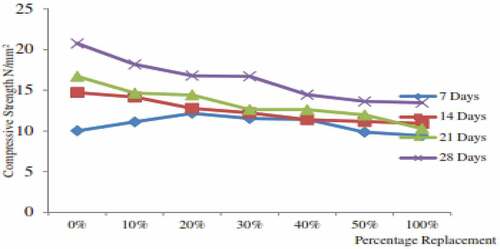
Table 6. Compressive strength of different shells from previous studies (Eziefula et al., Citation2018; Tayeh et al., Citation2019)
Tayeh et al. (Citation2020) investigated the strength development of concrete containing 5–20% seashell ash at a step of 5% as a partial replacement for cement. It was found that the addition of seashell reduced the early strength of concrete, which was attributed to the reaction of high content CaO in seashell ash powder with Al2O3 and gypsum. Also, all the concretes containing seashell ash exhibited lower compressive strength except the concrete with 5% seashell ash, which had a slightly higher compressive strength value than the control at 28 days (). However, all the concrete exceeded the targeted strength of 25 MPa at 28 days, except for concrete containing 20% seashell ash.
Figure 9. Variation of compressive strength of concrete with different content of seashell as a replacement for cement (Tayeh et al., Citation2020)
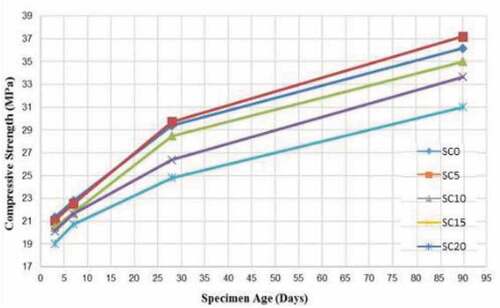
5.2. Splitting tensile strength
Previous studies show a trend similarity between split tensile and compressive strength of concrete containing seashells. In self-compacting concrete, the split tensile strength was recorded at a ten percent substitution of oyster shell ash powder in the mix (Abinaya & Venkatesh, Citation2016). The study by Yang et al. (Citation2005) revealed that the growth of tensile strength in high-performance concrete at an early age is high when comparing the change in strength with the seashell’s replacement ratio. At age 28 days, a slight decrease in tensile strength is observed compared to the usual mix. Because of the impact of the water–cement ratio, an amount of change is obtained at an early age, and the concentration of stresses occurs in the Oyster shell mix at old age. Varhen et al. (Citation2017) agreed with Yang et al. (Citation2005) as the tensile test after 28 days indicated no significant variation when Peruvian scallop crushed shell replacement increased, with a slight decrease at 28 days. According to Martínez-García et al. (Citation2017), mussel shells’ introduction as aggregate decreases the strength property by about 10%, independent of the substitution ratio. Eziefula et al. (Citation2018) mentioned the flaky shape, absorption capacity, and organic substance present in the mussel shell as an influential factor. The substitution of seashells as aggregate reduces the split tensile strength of concrete. The compressive strength and its utilization as sand replacement are more influenced than gravel replacement (Martínez-García et al., Citation2017). The introduction of seashells in pervious concrete shows smaller compressive strength results than control mixes of pervious concrete. The tensile strength also reduces between 11.8% and 28.8% (D. H. Nguyen et al., Citation2017). The split tensile strength of the concrete is dependent on the matrix strength, with the presence of seashell not affecting its resistance (Varhen et al., Citation2017). The results of other split tensile strength tests in different researches are shown in .
Table 7. Summary of split tensile strength results of previous studies (Tayeh et al., Citation2019)
Tayeh et al. (Citation2020) reported that the splitting tensile strength of concrete increased with the inclusion of up to 10% seashell ash, while further increase in the content of seashell ash resulted in a decrease in the splitting tensile strength value of concrete. The enhancement of splitting tensile strength of concrete with a maximum of 10% seashell ash was attributed to seashell ash’s fiber nature and its better binding ability with aggregate. The seashell ash’s filling ability was also stated as an advantage, which resulted in improved binding between concrete particles.
5.3. Flexural strength
The flexural strength of concrete containing seashell as a partial replacement for fine or coarse aggregate shows similar characteristics as compressive and tensile strength (Eziefula et al., Citation2018). As a function of curing age, the flexural strength of shell concrete increases at various percentages of substitution (Bamigboye et al., Citation2020). About self-compacting concrete at 0%, there is a reduction in flexural strength attributed to the crushed shell’s angular shape (Safi et al., Citation2015). Similar results were attained when crushed scallop seashell was substituted as fine aggregate after 28 days at 10%, 20%, and 30%. The strength was reported as 6.95 MPa, 6.65 MPa, and 6.37 MPa, respectively (Chandra et al., Citation2020). Contrary to results obtained from seashell substituted as fine aggregate, its effect as coarse aggregate replacement indicated an increase in flexural strength for 7%, 14%, 21% substitution ratio, and a decrease at 28%, as shown in (Raseela & George, Citation2019).
Figure 10. The flexural strength of concrete at different percentages of substitution as coarse aggregate (Raseela & George, Citation2019)
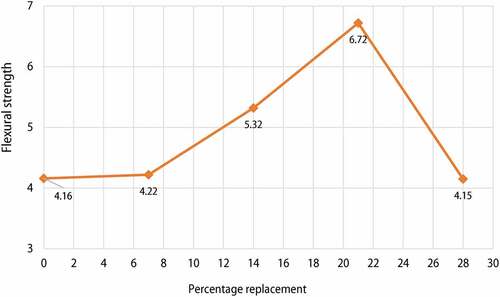
5.4. Modulus of elasticity
Monita-Olivia. et al. (Citation2015) stated in their study that the modulus of concrete elasticity with the seashells content after 7, 28, and 91 days was smaller compared to ordinary Portland cement-based mixes as a result of the zone of interfacial transition between the cement paste and aggregate. Also, a decrease was obtained in the elasticity modulus of concrete using an Oyster shell as a substitute to fine aggregate (Yang et al., Citation2005). Furthermore, at a 20% substitution ratio of Oyster shell as fine aggregate, the elasticity value decreases by about 10–15% compared to other substitution cases (Yang et al., Citation2010). Safi et al. (Citation2015) further reported a slight reduction in the elasticity value of self-compacting mortars related to sand substitution with seashells. According to Martínez-García et al. (Citation2017), there is also a significant decrease with mussel shell aggregate. The study results showed that a substitution ratio of less than 25% sustains the reduction in modulus below 25%, and at a substitution ratio of 50% or 100%, growth reduces by 50%. In non-structural and structural concrete, the effect of a reduced elasticity value in concrete with mussel shell was more profound for substituting coarse aggregate, as indicated in .
Figure 11. Modulus of elasticity of mussel shell substituted as coarse and fine aggregate (Martínez-García et al., Citation2017)
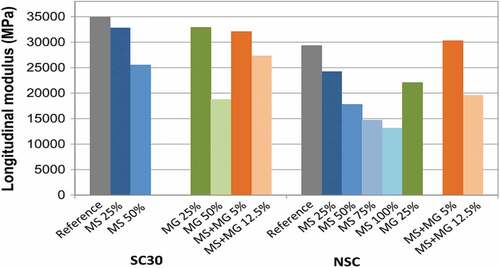
5.5. Relationship between compressive strength, flexural strength, tensile strength, and elastic modulus
illustrates the relationship between the compressive strength and flexural strength of the periwinkle shell, a model in the form, ff = an (fc)b where fc is the compressive strength, ff is the flexural strength (Eziefula et al., Citation2018). also illustrated the relationship between tensile and compressive strength for partial replacement of fine aggregate with 5%, 20%, 40%, and 60% Scallop shell, which generated a validated model of ft = a (fc)b (Varhen et al., Citation2017). Another relationship illustrated in indicates a model of Rt = 0.137Rc + 0.253 when crushed crepidula shell of 2/4 mm and 4/6.3 mm is substituted for coarse aggregate at 20% and 40% (Hanh et al., Citation2013). Furthermore, the relationship between tensile and compressive strength of Senilia Senilis seashells, substituted for coarse aggregate at 10%, 20%, 30%, 40%, and 50%, is illustrated in (Bamigboye et al., Citation2020). presents the relationship between compressive strength and elastic modulus of Oyster shell concrete substituted for fine aggregate at 5%, 10%, 15%, 20%, and the model indicated a more conservative result than experimental results (Yang et al., Citation2005).
Figure 12. [a] Relationship between flexural and compressive strength of periwinkle shell aggregate (Ekop et al. (Citation2013)), [b] Tensile strength and compressive strength for partial replacement of Scallop shell fine aggregate (Varhen et al., Citation2017), [c] Tensile strength and compressive strength for partial replacement of crepidula shell for coarse aggregate (Hanh et al., Citation2013), [d] Relationship between tensile and compressive strength of senilia senilis seashells substituted for coarse aggregate (Bamigboye et al., Citation2020), [e] Relationship between compressive strength and elastic modulus of oyster shell concrete substituted for fine aggregate (Yang et al., Citation2005)
![Figure 12. [a] Relationship between flexural and compressive strength of periwinkle shell aggregate (Ekop et al. (Citation2013)), [b] Tensile strength and compressive strength for partial replacement of Scallop shell fine aggregate (Varhen et al., Citation2017), [c] Tensile strength and compressive strength for partial replacement of crepidula shell for coarse aggregate (Hanh et al., Citation2013), [d] Relationship between tensile and compressive strength of senilia senilis seashells substituted for coarse aggregate (Bamigboye et al., Citation2020), [e] Relationship between compressive strength and elastic modulus of oyster shell concrete substituted for fine aggregate (Yang et al., Citation2005)](/cms/asset/768ec27c-69c4-44af-af08-121d9fa93b0f/oaen_a_1883830_f0012_oc.jpg)
6. Durability properties of concrete containing seashells
6.1. Freeze-thaw resistance
Concrete has tendencies of been damaged if it is subjected to full cycles of freeze-thaw. The resistance to freeze-thaw by concrete containing seashells is often assessed using the NF EN 1338, ASTM C666, and Chinese National standard (Yang et al., Citation2010; W. Wang et al., Citation2020; Hanh et al., Citation2017). Eziefula et al. (Citation2018) reported that the variable rate of the oyster shell’s weight and dynamic elastic modulus concrete presented better values than control concrete. In their studies, Yang et al. (Citation2010) also showed results that indicate that despite the increase in the cycles of freezing and thawing, the variable rates of the dynamic elastic modulus and weight of concrete replaced with Oyster shell indicated a better resistance to freezing and thawing. Also, a fine grain of Oyster shell, which occupied the entrapped air void of the concrete, was mentioned as the reason behind the improvement. Contrary to other results, two series of tests on pervious concrete using crushed seashells showed results as off-state due to the freeze-thaw effect, concluding that concrete with seashell has weak durability compared to controlled pervious concrete (Hanh et al., 2017). The durability performance of pervious concrete with seashells can be improved with Silica fume’s inclusion (W. Wang et al., Citation2020), as indicated in .
Figure 13. Relationship between the percentage of mass loss and freeze-thaw cycles (W. Wang et al., Citation2020)
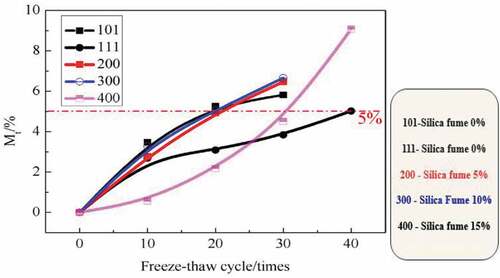
6.2. Water permeability
Compared to the number of seashell-based research, reports on permeability are rarely recorded (Tayeh et al., Citation2019). In their study, Yang et al. (Citation2010) stated that concrete tightness and pore structure affect concrete durability. Although standard concrete is lesser, the permeability resistance increases with an increase in substitution ratio, as indicated in , due to the elongated and flaky shape of the Oyster shell compared to sand. Hanh et al. (Citation2013), in their study, used a permeameter to measure the permeability coefficient for pervious concrete with seashells substituted at 60%, and results indicated that the porosities are exponentially proportional to the change in the form of the permeability in pervious concrete, but recommended its use as a surface layer for pavement structures. Furthermore, standard concrete had less permeability than concrete mixtures with cockle shell ash after 28 days and 90 days. Still, it was lower after 120 days because of a slower hydration process of seashell powder ash than cement (Othman et al., Citation2013). The use of mussel shells as aggregates replacement, as indicated in , reduces the water permeability of the concrete, especially when substituted for coarse aggregate (Martínez-García et al., Citation2017). Similarly, Richardson and Fuller (Citation2013) reported reductions of 17% to 36% and 21% to 36% in the porosity of concrete containing 10–50% seashells as a replacement for coarse and fine aggregates, respectively.
Figure 14. Water permeability (Martínez-García et al., Citation2017)
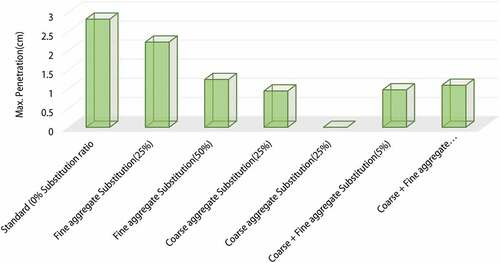
Table 8. Permeability characteristics with the substitution ratio of the oyster shell (Yang et al., Citation2010)
6.3. Air content
Regarding air content, Hung et al. (Citation2018), citing Cuadrado-Rica et al. (Citation2016), stated that the entrapped air increases at 60% replacement of Scallop shell with fine aggregate flat elongated shape of the shell and the effect of organic substances. Varhen et al. (Citation2017) mentioned that investigating Peruvian scallop shells’ combination as fine aggregate in concrete showed no significant change in the air content present than the amount in controlled concrete. shows the effect of air content on Peruvian scallops used as fine aggregates. Constant values were obtained irrespective of the Oyster shell’s replacement percentage and attributed it to entrapped air during the concrete mixing (Yang et al., Citation2005). Khankhaje et al. (Citation2017) also illustrated that air content increases by 2%, 4%, and 20% as the percentage of Cockleshells were increased by 25%, 50%, and 75%, which could be caused by the angular shape of the Cockleshell whose effect, decreases the compactness and disturbs the granular arrangement.
Figure 15. Air content effect of Peruvian scallop used as fine aggregate (Varhen et al., Citation2017)
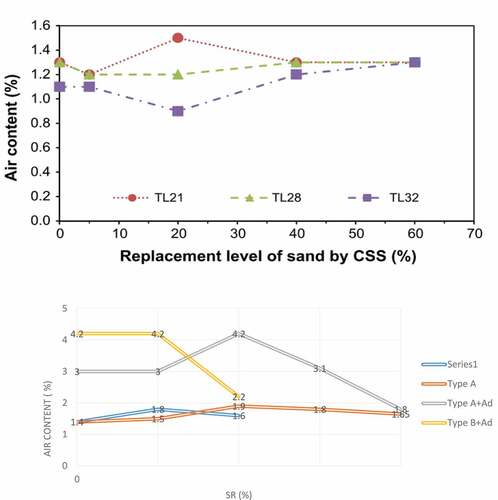
Nevertheless, to further minimize air content, the air-entrained admixture is needed (Yang et al., Citation2005). Still, the rate of growth and the percentage of replacement of the Oyster shell is quite variable. and show the air content variance with the replacement ratio of the Oyster shell. Eo and Yi (Citation2014) reported the increase in air content of concrete with w/c of 0.55 from 2.2% to 5.6% as the substitution level of oyster shells increased from 0% to 50%, as shown in . The increase in air content with an increase in oyster shell content was attributed to rough grading of crushed oyster shell and their porous nature.
6.4. Chemical attack of concrete containing seashell
The increase in substitution ratio of seashells as an aggregate of concrete had no significant effect on the resistance of concrete against chemical attack because the attack has been reported to increase gradually with time (Yang et al., Citation2010). Previous studies have subjected seashell concrete to chemical attacks using sulphuric acid and hydrochloric acid, as shown in . Kuo et al. (Citation2013), in their research using the Oyster shell as a fine aggregate replacement, report similar findings to that of Yang et al. (Citation2010) but attributed the cause to the reaction between the acid and CaCO3 content in the shell. However, Oyster shell concrete subjected to 2% hydrochloric acid attack did not indicate continuous weight loss after 21 days (Yang et al., Citation2010). The Cockleshell’s partial replacement as coarse aggregate gave the maximum advantage to the concrete resistance to chemical attack with less than 1% loss after 60 days curing in sulphuric acid (Raseela & George, Citation2019).
Figure 16. Oyster shell concrete weight loss after hydrochloric and sulfuric acid attack (Yang et al., Citation2010)
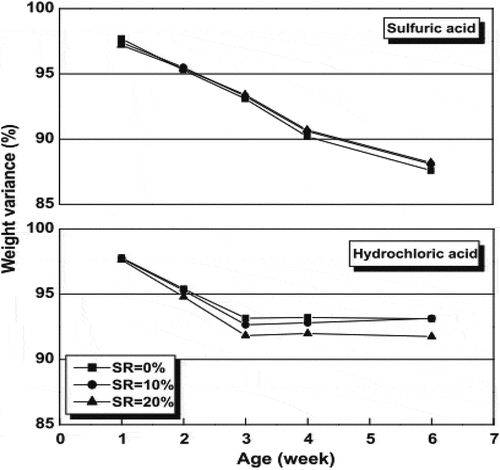
Tayeh et al. (Citation2020) found that the concrete containing 5% seashell ash had the least strength reduction after exposure to sulphate and alkaline attack compared with the control and the seashell ash contents greater than 5%. According to the authors, the infiltration of SO42 could cause gypsum formation within the microstructure resulting in expansion due to ettringite formation. The variation of the loss of compressive strength of concrete containing seashell ash after exposure to salt attacks is shown in .
6.5. Carbonation
The carbonation test records the depth of penetration by carbon dioxide into the concrete. Previous studies on the effect of carbonation on concrete with seashell aggregate substitute accounted that carbonation depth is not dependent on the substitution ratio. Still, the depth increase is directly proportional to the period of carbonation (Yang et al., Citation2010). According to , the results showed an increase in carbonation depth at different time frame irrespective of the percentage of substitution of Oyster shell as fine aggregates.
Figure 18. Carbonation depth of concrete with Oyster shell aggregate (Yang et al., Citation2010)
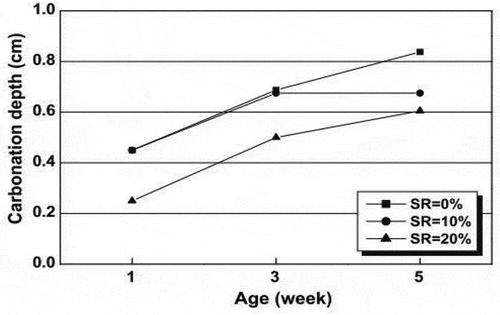
6.6. Shrinkage and weight loss
Studies showed a variation of shrinkage with an increase in substitution ratio of Oyster shell. Based on regression analyses, it was reported that the rise in shrinkage was 7% and 28% at a substitution ratio of 10% and 20% (Yang et al., Citation2010). According to ), Kuo et al. (Citation2013) stated that change in volume shrinkage is proportional to age. The least change in volume was at 0% replacement with −0.063%, and 50% shrinkage was recorded after 20% replacement. The more the percentage replacement, the greater the shrinkage percentage, which was attributed to the Oyster shell’s high absorption rate and increased internal structure’s moisture content. Mussel shells’ application as a replacement to fine aggregate in concrete increases the concrete weight loss even in small substitution percentages (Martínez-García et al., Citation2017). However, the property is not affected when a coarse mussel shell is used as an aggregate with similarity present in controlled concrete. Results also reported that mussel shells show high water absorption capacity compared to natural sand, indicating that the more fine mussel shell sand, the higher the weight loss of concrete (Martínez-García et al., Citation2017). shows the percentage of weight loss when the mussel shell is utilized as a partial replacement for fine and coarse aggregate.
Figure 19. Percentage of weight loss of oyster shell utilized as a partial fine aggregate replacement [a], mussel shell utilized as a partial replacement for fine and coarse aggregate [b] (Kuo et al., Citation2013; Martínez-García et al., Citation2017)
![Figure 19. Percentage of weight loss of oyster shell utilized as a partial fine aggregate replacement [a], mussel shell utilized as a partial replacement for fine and coarse aggregate [b] (Kuo et al., Citation2013; Martínez-García et al., Citation2017)](/cms/asset/7704c1cf-bc6a-41b2-ab0b-00af67719e18/oaen_a_1883830_f0019_oc.jpg)
Eo and Yi (Citation2014) found that the drying shrinkage of concrete was higher at an early age with oyster shells’ addition as a replacement for fine aggregate. However, the extent of drying shrinkage reduced drastically with an increase in the oyster shell’s substitution level at a later age. The variation of drying shrinkage of concrete with the oyster shell as a replacement for fine aggregate is present in .
Figure 20. Drying shrinkage of concrete with the oyster shell as a replacement for fine aggregate (Eo & Yi, Citation2014)
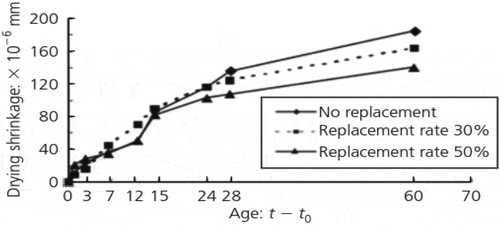
7. Limitation of the current study and future improvement
Although more research has been conducted substituting seashells with cement at various percentages, this study was limited to durability and mechanical assessment of concrete containing seashells at a different percentage of replacement. Despite the previous studies on seashells, the following areas need to be looked into:
The outcome of including seashell in reinforced concrete with checks on the ultimate and serviceability limit state, the cost analysis of substituting seashells in concrete at a different percentage of better mechanical and durability results, the reaction of seashell concrete to sound absorption, thermal insulation, odor, alkali-aggregate
More studies should be done on seashell effect on special concretes such as high-density aggregate concrete, Sprayed concrete, High-strength concrete, Underwater concrete, Foamed concrete, Aerated and Recycled concrete.
The thaumasite form of sulfate attack should be studied in the durability properties of concrete containing seashells. Thaumasite as a mineral rarely occurs in limestone, and its attack is most noticeable in buried concrete.
Durability tests on seawater and fire effect should be further investigated because saltwater promotes degradation processes like alkali-aggregate reaction and corrosion. In contrast, fire at a different temperature, time of exposure eventually degrade concrete.
The strength (compressive, split tensile, and flexural) and durability of seashells concrete at late ages to study its behavior for 1 year and beyond.
8. Conclusion
This study has discussed the durability and mechanical assessment of concrete containing seashells. Based on knowledge acquired while studying other researches, the following conclusions were established.
Compressive strength after 28 days of seashell substituted as coarse aggregate has a better relationship than that replaced as fine aggregate.
The compressive, tensile, and flexural strength of concrete with seashell as an aggregate replacement reduces with an increase in percentage replacement and increases with curing age.
Concrete partially replaced with seashells as fine aggregate exhibits more weight loss of up to 50% with an increase in substitution ratio compared to a weight loss of concrete replaced with seashells as coarse aggregate, whose result showed similarity in a weight loss of control concrete mixes.
The effect of seashells on the durability properties of concrete varies at the various percentages of replacement. Freeze-thaw resistance, water permeability, shrinkage, weight loss, and air content properties depend on the percentage of substitution. At the same time, carbonation and chemical attack are independent of the effect of it.
Acknowledgements
The authors wish to thank the chancellor and Covenant University management for the platform made available for this research work.
Additional information
Funding
Notes on contributors

Gideon Bamigboye
Gideon O. Bamigboye is currently a Senior Lecturer in the Department of Civil Engineering, Covenant University, Ota, Ogun State, Nigeria. His research focuses on innovative construction materials, environmental sustainability, and concrete infrastructure.
David Enabulele is a research student in the Civil Engineering Department, Covenant University. His research interest is in the area of concrete infrastructure.
Abimbola Odetoyan is a lecturer in the Civil Engineering Department, Covenant University. His research interests are in the areas of concrete infrastructure and environmental sustainability.
Mutiu Kareem is a lecturer in the Civil Engineering Department, Osun State University. His research interest is in the areaof concrete infrastructure.
Austin Nworgu is a research student in the Civil Engineering Department, Covenant University. His research interest is in the area of concrete infrastructure.
Daniel Bassey is a research student in the Civil Engineering Department, Covenant University. His research interest is in the area of environmental sustainability.
References
- ABC net, (May 5, 2017), war on waste recycling shells from your plate, https://www.abc.net.au/news/2017-05-18/war-on-waste-recycling-shells-from-your-plate/8533652 ( Accessed March 27, 2020).
- Abdelouahed, A., Hebhoub, H., Kherraf, L., & Belachia, M. (2019). Effect of cockle shells on mortars performance in extreme conditions. Civil and Environmental Engineering Reports, 29(2), 60–40. https://doi.org/10.2478/ceer-2019-0017.
- Abdulfattah, M. (2001). Determination of chemical analysis using pellets, a laboratory manual of quality control pp.(1–12). Ashakacem Plc.
- Abinaya, S., & Venkatesh, S. P. (2016). An effect on oyster shell powder’s mechanical properties in self compacting concrete. Int. Journal of Innovative Research in Sci., Eng. And Tech, 5(6), 11785–11789. https://doi:10.15680/IJIRSET.2016.0506296
- Adewuyi, A. P., & Adegoke, T. (2008). Exploratory study of periwinkle shells as coarse aggregates in concrete works. ARPN Journal of Engineering and Applied Sciences, 3(6)1–5.
- Adewuyi, A. P., Franklin, S. O., & Ibrahim, K. A. (2015). Utilization of mollusc shells for concrete production for a sustainable environment. International Journal of Scientific & Engineering Research, 6(9), 201.
- Agbede, O. I., & Manasseh, J. (2009). Suitability of periwinkle shell as a partial replacement for river gravel in concrete. Leonardo Electronic Journal of Practices and Technologies, 15, 59–66.
- Agwu, O. E., Akpabio, J. U., & Akpabio, M. G. (2020). Potentials of waste seashells as additives in drilling muds and in oil well cements. Cleaner Engineering and Technology, 1(2), 100008. https://doi.org/10.1016/j.clet.2020.100008
- Alam, S., Veedu, J., & Dhasan, T. (2018). Experimental analysis on strength and durability of concrete by partially exchanging fine aggregate with oyster shell. International Journal of Creative Research Thoughts (IJCRT), 6(4), 866–873.
- Ammari, M. Z., Ghoraishi, M., Abidou, A., & Al-Rousan, R. Z. (2017). Sand with crushed seashells and its effect on the strength of mortar and concrete used in the united arab emirates. International Journal of Civil Engineering and Technology (IJCIET), 8, 462–470.
- Inyan A. E., & Etuk, B. R. (2016). The effect of calcination temperature on the chemical composition of oyster, periwinkle, and snail shell ash. International Journal of Renewable Energy Technology, 5(8), 200–203.
- ASTM C109/109M. (2000). Standard test method for compressive strength of hydraulic cement mortars (using 2-in. or [50-mm] cube specimens). American Society for Testing and Materials.
- ASTM C33/C33M-18. (2018). Standard specification for concrete aggregates. American Society for Testing and Materials.
- ASTM C39/C39M-20. (2020). Standard test method for compressive strength of cylindrical concrete specimens. American Society for Testing and Materials.
- ASTM C617/C617M 15. (2015). Standard practice for capping cylindrical concrete specimens. . American society for testing and materials–committee c09 on concrete and concrete aggregates–subcommittee C (Vol. 9).
- ASTM, ASTM C150. (2017). Standard specification for Portland cement. American Society for Testing and Materials.
- Attah, C., Etim, R. K., & Sani, J. E. (2019). Response of oyster shell ash blended cement concrete in sulphuric acid environment. Civil and Environmental Research, 11(4), 8–26.
- Azunna, S. U. (2019). Compressive strength of concrete with palm kernel shell as a partial replacement for coarse aggregate. SN Applied Sciences, 1(4), 342. https://doi.org/10.1007/s42452-019-0334-6
- Bamigboye, G. O., Adedeji, A. A., Olukanni, D. O., Omoleye, J. A., & Jolayemi, K. J. (2019). Influence of granite-gravel combination on the strength of self-compacting concrete: Towards a sustainable construction material. Journal of Engineering Science and Technology (JESTEC), 14(5), 2746–2760.
- Bamigboye, G. O., Nworgu, A. T., Odetoyan, A. O., Kareem, M., Enabulele, D. O., Daniel, E., & Bassey, D. E. (2021a). Sustainable use of seashells as binder in concrete production: Prospect and challenges. Journal of Building Engineering, 34, 101864. https://doi.org/10.1016/j.jobe.2020.101864
- Bamigboye, G. O., Okara, O., Bassey, D. E., Jolayemi, K. J., & Ajimalofin, D. (2020). The use of senilia senilis seashells as a substitute for coarse aggregate in eco-friendly concrete. Journal of Building Engineering, 32, 101811. https://doi.org/10.1016/j.jobe.2020.101811
- Bamigboye, G. O., Tarverdi, K., Wali, E. S., Bassey, D., & Jolayemi, K. J. (2021b). Effects of dissimilar curing systems on the strength and durability of recycled PET-modified concrete. Silicon, 1-13, https://doi.org/10.1007/s12633-020-00898-0
- Brahim, S., Mohammed, S., Abdelhakim, D., Ahmed, B., Ali, M., & Kamel, T. (2015). The use of seashells as fine aggregate (by sand substitution) in a self-compacting mortar (SCM). Construction and Building Materials, 78, 430–438.
- Chandra, K., Behera, S., & Jena, S. (2020). Effect of rice husk ash on mechanical properties of concrete containing crushed seashell as fine aggregate. Materials Today: Proceedings, 32, 838–843. https://doi.org/10.1016/j.matpr.2020.04.049
- Chiou, I. J., Chen, C. H., & Li, Y. H. (2014). Using oyster-shell foamed bricks to neutralize the acidity of recycled rainwater. Construction and Building Materials, 64(480), 480–487. https://doi.org/10.1016/j.conbuildmat.2014.04.101
- Cuadrado-Rica, H., Sebaibi, N., Boutouil, M., & Boudart, B. (2015). Properties of concretes incorporating crushed queen scallops for artificial reefs. In RECIF conference on artificial reefs: From materials to ecosystems. Materials and Structures, 49(5), 1–12.
- Cuadrado-Rica, H., Sebaibi, N., Boutouil, M., & Boudart, B. (2016). Properties of ordinary concretes incorporating crushed queen scallop shells. Materials and Structures, 49(5), 1805–1816. https://doi.org/10.1617/s11527-015-0613-7
- Dankwah, J. R., & Nkrumah, E. (2016). Recycling blends of rice husk ash and snail shells as partial replacement for Portland cement in building block production. Ghana Journal of Technology, 1(1), 67–74.
- Djobo, Y., Elimbi, A., Manga, J. D., & Ndjock, I. D. L. (2016). Partial replacement of volcanic ash by bauxite and calcined oyster shell in the synthesis of volcanic ash-based geopolymers. Construction Building Material, 113, 673–681. https://doi.org/10.1016/j.conbuildmat.2016.03.104
- Ekop, I. E., Adenuga, O. A., & Umoh, A. A. (2013). Strength characteristics of granite-pachymelania aurita shell concrete. Nigerian Journal of Agriculture, Food and Environment, 9(2), 9–14.
- Elliott, R. A., & Fuller, T. (2013). Seashells used as partial aggregate replacement in concrete. Structural. Survey, 31(5), 347–354. https://doi.org/10.1108/SS-12-2012-0041
- EN 12390–12393, Testing hardened concrete-Part 3: Compressive strength of test specimens. European Committee for Standardization (2012).
- Eo, S. H., & Yi, S. T. (2014). Effect of oyster shell as an aggregate replacement on the characteristics of concrete. Magazine of Concrete Research, 67(15), 833–842. https://doi.org/10.1680/macr.14.00383
- Ettu, L. O., Ibearugbulem, O. M., Ezeh, J. C., & Anya, U. C. (2013). A reinvestigation of the prospects of using periwinkle shell as partial replacement for granite in concrete. International Journal of Engineering Science Invention, 2(3), 54–59.
- Eziefula, U. G., Ezeh, J. C., & Eziefula, B. I. (2018). Properties of seashell aggregate concrete : A review. Construction and Building Materials, 192, 287–300. https://doi.org/10.1016/j.conbuildmat.2018.10.096
- Eziefula, U. G., Obiechefu, G. C., & Charles, M. E. (2020). Use of periwinkle shell by-products in Portland cement-based materials: An overview. International Journal of Environment and Waste Management, 26(3), 362–388. https://doi.org/10.1504/IJEWM.2020.109165
- Eziefula, U. G., Opara, H. E., & Anya, C. U. (2017). Mechanical properties of palm kernel shell concrete in comparison with periwinkle shell concrete. Malaysian Journal of Civil Engineering, 29, 1–14.
- Ez-zaki, H., Diouri, A., Kamali-Bernard, S., & Sassi, O. (2016). Composite cement mortars based on marine sediments and oyster shell powder. Materiales de Construction, 66, 080.
- Falade, F. (1995). An investigation of periwinkle shells as coarse aggregate in concrete. Building and Environment, 30(4), 573–577. https://doi.org/10.1016/0360-1323(94)00057-Y
- Falade, F., Ikponmwosa, E. E., & Ojediran, N. I. (2010). Behaviour of lightweight concrete containing periwinkle shells at elevated temperature. Journal of Engineering Science and Technology, 5(4), 379–390.
- FAO (Food and Agriculture Organization of the United Nations). the state of world fisheries and aquaculture 2016: Contributing to Food Security and Nutrition for All. Rome, Italy, (2016). Food and Agricultural Organization. See http://www.fao.org/3/a-i5555e.pdf ( accessed 27 September 2017).
- FAO, (Food and Agriculture Organization of the United Nations). (2014). The state of world fisheries and aquaculture. Food and Agricultural Organization.
- Fatemeh, S., Mojtaba, E., Ali, E., & Zahra, S. (2018). Development and characterization of blended cement containing seashell powder. Construction Building Materials, 161, 292–304. https://doi.org/10.1016/j.conbuildmat.2017.11.111
- Gadgihalli, V., Prasad, R., Dinakar, H., & Sharma, S. C. (2017). Analysis of properties of concrete using sea shells crushed powder as admixture. International Journal of Research-GRANTHAALAYAH, 5(11), 374–378. https://doi.org/10.5281/zenodo.1117283
- Gonzalez-Corominas, A., Etxeberria, M., & Poon, C. S. (2016). Influence of the quality of recycled aggregates on the mechanical and durability properties of high-performance concrete. Journal of Waste Biomass Valorization, 8(5), 1421–1432. https://doi.org/10.1007/s12649-016-9637-7
- Hamestera, M. R., Balzera, P. S., & Beckerb, D. (2012). Characterization of calcium carbonate obtained from oyster and mussel shells and incorporation in polypropylene. Materials Research, 15(2), 204–208. https://doi.org/10.1590/S1516-14392012005000014
- Hanh, D., Boutouil, M., Sebaibi, N., Baraud, F., & Leleyter, L. (2017). Durability of pervious concrete using crushed seashells. Construction and Building Materials, 135, 137–150. https://doi.org/10.1016/j.conbuildmat.2016.12.219
- Hanh, D., Boutouil, M., Sebaibi, N., Leleyter, L., & Baraud, F. (2013). Valorization of seashell by-products in pervious concrete pavers. Construction and Building Materials, 49, 151–160. https://doi.org/10.1016/j.conbuildmat.2013.08.017
- Hazurina, N., Hisham, A. B. B., Mat, D. M., & Azmi, M. J. M. (2013). Potential use of cockle (anadaragranosa) shell ash as partial cement replacement in concrete. Caspian Journal of Applied Sciences Research, 2, 369–376.
- Hung, K., Alengaram, U. J., Zamin, M., & Cheng, S. (2018). Recycling of seashell waste in concrete : A review recycling of seashell waste in concrete : A review. Construction and Building Materials, 162, 751–764. https://doi.org/10.1016/j.conbuildmat.2017.12.009
- Islam, M. R., Ishiguro, S., & Yamanaka, M. (2015). Surface heat reduction of asphalt concrete by top filling with mortar prepared by oyster shell aggregate and ground granulated blast furnace slag and their strength in different curing condition. ??????????, IDRE Journal, 296 (83-2), 1–7.
- Ismail, N. N., Othman, N. H., Inn, G. W., & Sainudin, M. S. (2019). Physical and mechanical properties of concrete containing green mussel (Perna viridis) shell ash as an admixture. In IOP Conference Series: Materials Science and Engineering. 601(1), 012034. IOP Publishing.Universiti Tun Hussein Onn Malaysi.
- Khankhaje, E., Rafieizonooz, M., Razman, M., & Mirza, J. (2017). Comparing the effects of oil palm kernel shell and cockle shell on properties of pervious concrete pavement. International Journal of Pavement Research and Technology, 10(5), 383–392. https://doi.org/10.1016/j.ijprt.2017.05.003
- Kim, H. M., Johnson, A., Mohd, Z. J., Siew, C. L., Wan, I. G., & Choon, W. Y. (2018). Recycling of Seashell Waste in Concrete: A Review Construction and Building Materials, 162(20), 751–764. https://doi.org/10.1016/j.conbuldmat.2017.12.009
- Kumar, N. V. S., & Ram, K. S. (2019). Performance of concrete at elevated temperatures made with crushed rock dust as filler material. Material Today: Proceedings, 18, 2270–2278.
- Kumar, P. S., Kumar, C. S., Yuvaraj, P., Kumar, B. M., & Mohan, E. K. J. (2016). A partial replacement for coarse aggregate by sea shell and cement by lime in concrete. Imperial Journal of Interdisciplinary Research, 2(5), 1131–1136.
- Kuo, W., Wang, H., Shu, C., & Su, D. (2013). Engineering properties of controlled low-strength materials containing waste oyster shells. Construction and Building Materials, 46, 128–133. https://doi.org/10.1016/j.conbuildmat.2013.04.020
- Lalitha, G., & Raju, C. K. (2014). Experimental study on the performance of concrete M30 with partial replacement of coarse aggregate with seashells and coconut shells. International Journal of Engineering Research in Africa, 4(8), 148–151.
- Lertwattanaruk, P., Makul, N., & Siripattarapravat, C. (2012). Utilization of ground waste seashells in cement mortars for masonry and plastering. Journal of Environmental Management, 111, 133–141. https://doi.org/10.1016/j.jenvman.2012.06.032
- Li, G., Xu, X., Chen, E., Fan, J., & Xiong, G. (2015). Properties of cement-based bricks with oyster-shells ash. Journal of Cleanear Production, 91, 279–287. https://doi.org/10.1016/j.jclepro.2014.12.023
- Martínez-García, C., González-Fonteboa, B., Martínez-Abella, F., & Carro-López, D. (2017). Performance of mussel shell as aggregate in plain concrete. Construction and Building Materials, 139, 570–583. https://doi.org/10.1016/j.conbuildmat.2016.09.091
- Matias, D., de Brito, J., Rosa, A., & Pedro, D. (2014). Durability of concrete with recycled coarse aggregates: Influence of superplasticizers. Journal of Materials in Civil Engineering, 26(7), 06014011. https://doi.org/10.1061/(ASCE)MT.1943-5533.0000961
- Mer, F. A. (2011). Les filières pêche et aquaculture en France. FranceAgricMer
- Ministry of Marine and Fisheries (MMF), (2007). Statistical of marine and fisheries(jakarta). Directorate General of Aquaculture, Ministry of Marine Affairs and Fisheries
- Mohamed, M., Yusup, S., & Maitra, S. (2012). Decomposition study of calcium carbonate in cockle shell. Journal of Engineering Science and Technology, 7(1), 1–10.
- Mohammad, W., Soffian, W. A., Othman, N. H., Wan Ibrahim, M. H., A Rahim, M., Shahidan, S., & Abd Rahman, R. (2017). A review on seashells ash as partial cement replacement. IOP Conf. Series: Materials Science and Engineering, 271, 012059 https://doi.org/10.1088/1757-899X/271/1/012059
- Monita-Olivia.,, Annisa, A. M., & Lita, D. (2015). Mechanical properties of seashell concrete. Procedia Engineering, 125, 760–764. https://doi.org/10.1016/j.proeng.2015.11.127
- Muthaiyan, U. M., & Thirumalai, S. (2017). Studies on the properties of pervious fly ash- cement concrete as a pavement material. Cogent Engineering, 4(1), 1318802. http://doi.org/10.1080/23311916.2017.1318802
- Muthusamy, K., & Sabri, N. A. (2012). Cockle shell: A potential partial coarse aggregate replacement in concrete. International Journal of Science, Environment and Technology, 1(4), 260–267.
- Muthusamy, K., Tukimat, N. N. A., Sarbini, N. N., & Zamri, N. A. (2016). Exploratory study on the use of crushed cockle shell as partial sand replacement in concrete. International Journal of Research in Engineering and Science, 4(2), 67–71.
- Mutusva, T., & H.G., N., C. (2015). Investigation of properties of concrete with seashells as a coarse aggregate replacement in concrete. MATTER: International Journal of Science and Technology, 1(1), 285–295. https://doi.org/10.3390/resources8010013
- Neamitha, M., & Muthadhi, A. (2016). Performance of pervious concrete with industrial waste as coarse aggregate e an overview. International Journal of Emerging. Technology And. Advanced Engineering, 6(9), 155–161.
- Nguyen, D. H., Boutouil, M., Sebaibi, N., Baraud, F., & Leleyter, L. (2017). Durability of pervious concrete using crushed seashells. Construction and Building Materials, 135, 137–150. https://doi.org/10.1016/j.conbuildmat.2016.12.219
- Nguyen, D. H., Boutouil, M., Sebaibi, N., Leleyter, L., & Baraud, F. (2013). Valorization of seashells by-product in pervious concrete paves. Construction and Building Materials, 49, 151–160. https://doi.org/10.1016/j.conbuildmat.2013.08.017
- Nordin, N., Hamzah, Z., Hashim, O., Kasim, F. H., & Abdullah, R. (2015). Effect of temperature in calcination process of seashells. Malaysian Journal of Analytical Sciences, 19(1), 65–70.
- Offiong, U. D., & Akpan, G. E. (2017). Assessment of physicochemical properties of periwinkle shell ash as a partial replacement for cement in concrete. Assessment, 1(7), 33–36.
- Olivia, M., Arifandita, A., & Darmayanti, L. (2015). Mechanical properties of seashell concrete. Procedia Engineering, 125, 760–764. https://doi.org/10.1016/j.proeng.2015.11.127
- Olivia, M., & Oktaviani, R. (2017). Properties of concrete containing ground waste cockle and clam seashells. Procedia Engineering, 171, 658–663. https://doi.org/10.1016/j.proeng.2017.01.404
- Ong, B. P., & Kassim, U. (2019). Performance of concrete incorporating of clam shell as partially replacement of ordinary Portland cement (OPC). Journal of Advanced Research in Applied Mechanics, 55(1), 12–21.
- Osarenmwinda, J. O., & Awaro, A. O. (2009). The potential use of periwinkle shell as coarse aggregate for concrete. Advanced Materials Research, 62-64, 39–43. https://doi.org/10.4028/www.scientific.net/AMR.62-64.39
- Othman, N. H., Bakar, B. H. A., Don, M., & Johari, M. (2013). Cockleshell ash replacement for cement and filler in concrete. Malaysian Journal of Civil Engineering, 25(2), 201-211. https://doi.org/10.11113/mjce.v25n2.303
- Otunyo, A. W., Friday, I. U., & Israel, T. A. (2013). Exploratory study of crushed periwinkle shell as partial replacement for fine aggregates in concrete. Journal of Emerging Trends in Engineering and Applied Sciences, 4(6), 823–827.
- Oyedepo, O. J. (2016). Evaluation of the properties of lightweight concrete using periwinkle shells as a partial replacement for coarse aggregate. Journal of Applied Sciences and Environmental Management, 20(3), 498–505.
- Pepe, M., Toledo Filho, R. D., Koenders, E. A., & Martinelli, E. (2014). Alternative processing procedures for recycled aggregates in structural concrete. Construction and Building Materials, 69, 124–132. https://doi.org/10.1016/j.conbuildmat.2014.06.084
- Ponnada, M. R., Prasad, S. S., & Dharmala, H. (2016). Compressive strength of concrete with partial replacement of aggregates with granite powder and cockle shell. Malaysian Journal of Civil Engineering, 28(2), 183–204. https://doi.org/10.11113/mjce.v28.15970.
- Pusit, L., Makul, N., & Siripattarapravat, C. (2012). Utilization of ground waste seashells in cement mortars for masonry and plastering. Journal of Environmental Management, 111, 133–141.
- Raseela, M. K. P., & George, B. M. S. (2019). Experimental investigation on use of cockle shell as partial coarse aggregate replacement in concrete. Concrete,” International, 4(2), 504–510.
- Richardson, A. L., & Fuller, T. (2013). Seashells used as partial aggregate replacement in concrete. Structural Survey, 31(5), 347–354. https://doi.org/10.1108/SS-12-2012-0041
- Safi, B., Saidi, M., Daoui, A., Bellal, A., Mechekak, A., & Toumi, K. (2015). The use of seashells as a fine aggregate (by sand substitution) in self-compacting mortar (SCM). Construction and Building Materials, 78, 430–438. https://doi.org/10.1016/j.conbuildmat.2015.01.009
- Sainudin, M. S., Othman, N. H., & Shahidan, S. (2019). Performance of concrete containing mussel shell (perna viridis) ash under effect of sodium chloride curing. In IOP Conference Series: Materials Science and Engineering, 601, 012033. https://doi.org/10.1088/1757-899X/601/1/012033.
- Schneider, M., Romer, M., Tschudin, M., & Bolio, H. (2011). Sustainable cement production—present and future. Cement and Concrete Research, 41(7), 642–650. https://doi.org/10.1016/j.cemconres.2011.03.019
- Silva, R. V., De Brito, J., & Dhir, R. K. (2014). Properties and composition of recycled aggregates from construction and demolition waste suitable for concrete production. Construction and Building Materials, 65, 201–217. https://doi.org/10.1016/j.conbuildmat.2014.04.117
- Singamneni, S., Behera, M. P., Le Guen, M., & Zeidler, H. (2018). Mechanism of bonding in seashell powder-based ceramic composites used for binder-jet 3D printing. Bioceram. Dev. Appl, 8(1), 2-7. https://doi.org/10.4172/2090-5025.1000108
- Sojobi, A. O., Nwobodo, S. E., & Aladegboye, O. J. (2016). Recycling of polyethylene terephthalte (PET) plastic bottle wastes in bituminous asphaltic concrete. Cogent Engineering, 3(1), 1133480. https://doi.org/10.1080/23311916.2015.1133480
- Soltanzadeh, F., Emam-Jomeh, M., Edalat-Behbahani, A., & Soltan-Zadeh, Z. (2018). Development and characterization of blended cements containing seashell powder. Construction and Building Materials, 161, 292–304.
- Soneye, T., Ede, A. N., Bamigboye, G., & Olukanni, D. O. (2016). The study of periwinkle shells as fine and coarse aggregate in concrete works. In: 3rd International Conference on African Development Issues (CU-ICADI).361–364. Covenant University, Nigeria. See http://eprints.covenantuniversity.edu.ng/6719/1/icadi16pp361-364.pdf(accessed 05 December 2020).
- Sugiyama, M. (2004). Freeze-thaw test results of porous concrete with crushed scallop shell material added. J. Hokkai-Gakuen Univ, 120, 1–6.
- Tayeh, B. A., Hasaniyah, M. W., Zeyad, A. M., Awad, M. M., Alaskar, A., Mustafa, A., & Alyousef, R. (2020). Durability and mechanical properties of seashell partially replaced cement. Journal of Building Engineering, 31, 101328. https://doi.org/10.1016/j.jobe.2020.101328
- Tayeh, B. A., Hasaniyah, M. W., Zeyad, A. M., & Olalekan, M. (2019). Properties of concrete containing recycled seashells as cement partial replacement : A review. Journal of Cleaner Production, 237, 117723. https://doi.org/10.1016/j.jclepro.2019.117723
- Umoh, A. A., & Ujene, A. O. (2015). Improving the strength performance of high volume periwinkle shell ash blended cement concrete with sodium nitrate as accelerator. Journal of Civil Engineering, Science and Technology, 6(2), 18–22.
- Varhen, C., Carrillo, S., & Ruiz, G. (2017). Experimental investigation of Peruvian scallop used as fine aggregate in concrete. Construction and Building Materials, 136, 533–540. https://doi.org/10.1016/j.conbuildmat.2017.01.067
- Wang, J., Liu, E., & Li, L. (2019). Characterization on the recycling of waste seashells with Portland cement towards sustainable cementitious materials. Journal of Cleaner Production, 220, 235–252. https://doi.org/10.1016/j.jclepro.2019.02.122
- Wang, W., Lin, F., Yan, B., Cheng, Z., Chen, G., Kuang, M., … Hou, L. (2020). The role of seashell wastes in tio2/seashell composites: Photocatalytic degradation of methylene blue dye under sunlight. Environmental Research, 188, 109831. https://doi.org/10.1016/j.envres.2020.109831
- Yang, E., Kim, M., Park, H., & Yi, S. (2010). Effect of partial replacement of sand with dry oyster shell on the long-term performance of concrete. Construction and Building Materials, 24(5), 758–765. https://doi.org/10.1016/j.conbuildmat.2009.10.032
- Yang, E., Yi, S., & Leem, Y. (2005). Effect of oyster shell substituted for fine aggregate on concrete characteristics : Part I. fundamental properties. Cement and Concrete Research, 35(11), 2175–2182. https://doi.org/10.1016/j.cemconres.2005.03.016
- Yao, Z., Xia, M., Li, H., Chen, T., Ye, Y., & Zheng, H. (2014). Bivalve shell: Not an abundant useless waste but a functional and versatile biomaterial. Critical Reviews in Environmental Science and Technology, 44(22), 2502–2530. https://doi.org/10.1080/10643389.2013.829763
- Yoon, G. L., Kim, B. O., Kim, B. O., & Han, S. H. (2003). Chemical-mechanical characteristic of crushed oyster-shell. Waste Management, 23(9), 825–834. https://doi.org/10.1016/S0956-053X(02)00159-9
- Yoon, H., Park, S., Lee, K., & Park, J. (2004). Oyster shell as substitute for aggregate in mortar. Waste Management & Research, 22(3), 158–170. https://doi.org/10.1177/0734242X04042456
- Zaid, S. T., & Ghorpad, V. G. (2014). Experimental investigation of snail shell ash (SSA) as partial replacement of ordinary Portland cement in concrete. International Journal of Engineering Research and Technology (IJERT), 3(10), 1049–1053.

